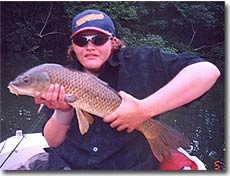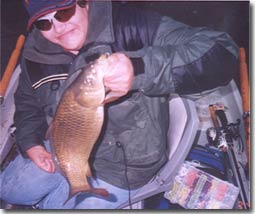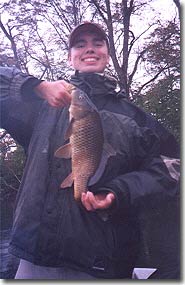Advanced Carp Strategies
Advanced Carp Strategies
By Richard Sims
Garbage fish? HA! Carp are, pound for pound, one of the greatest fighting freshwater fish in my opinion. They have a tendency to eat almost anything, bottom matter or even minnows, crawfish and frogs. You would be surprised at what these so called "bottom feeders" will eat. When you hook one, even a small one, you will see how amazing they can fight! A similar fighting freshwater fish would be pike or possibly salmon. Most people think they are lazy fish. By nature, yes they usually are... until they are hooked! I have seen carp jump 3 feet in the air, tailwalk and bulldog with the best of them. The truth is, there is a lot of muscle underneath those ugly mugs! This article will tell you all you need to know to catch carp consistently throughout the seasons.
 First of all, I must say that carp are not generally active fish and will not USUALLY hit fast moving lures. Quite often carp fishing is a game of still fishing and waiting. But there are several ways to put odds in your favour. First of all, fish shallow. These monster fish will move into the shallowest, muddiest water in order to search for their favourite food - worms. Shallow weeds often mean crawfish and minnows as well, so they will uproot the weeds to look for food. Seeing any type of boils in the mud or splashing probably means that they are feeding. Carp are basically a member of the minnow family, so you can almost always find them in schools. This makes catching them a lot easier most of the time. Always remember that carp are very, very spooky fish and even the slightest movement or noise can spook them away.. but never fear, usually they will either come back, or another school will move in to replace them. A way to attract schools to your fishing area is to "chum" by throwing handfuls of corn, cornmeal or oatmeal to the area that you are casting. I like to start "chumming 2 or 3 days before I actually go to fish a spot. You can almost train the carp to show up at that spot, even at the time that you chum! Usually you will want to cast fairly far away from yourself so that they don't get spooked from your movements.
First of all, I must say that carp are not generally active fish and will not USUALLY hit fast moving lures. Quite often carp fishing is a game of still fishing and waiting. But there are several ways to put odds in your favour. First of all, fish shallow. These monster fish will move into the shallowest, muddiest water in order to search for their favourite food - worms. Shallow weeds often mean crawfish and minnows as well, so they will uproot the weeds to look for food. Seeing any type of boils in the mud or splashing probably means that they are feeding. Carp are basically a member of the minnow family, so you can almost always find them in schools. This makes catching them a lot easier most of the time. Always remember that carp are very, very spooky fish and even the slightest movement or noise can spook them away.. but never fear, usually they will either come back, or another school will move in to replace them. A way to attract schools to your fishing area is to "chum" by throwing handfuls of corn, cornmeal or oatmeal to the area that you are casting. I like to start "chumming 2 or 3 days before I actually go to fish a spot. You can almost train the carp to show up at that spot, even at the time that you chum! Usually you will want to cast fairly far away from yourself so that they don't get spooked from your movements.
Baits
In my last carp fishing article, titled "Carp Basics" I told you about a simple carp rig. It basically shows a bell sinker and snelled hook, rigged with regular canned corn. This has indeed been my most successful tactic/rig. BUT some days carp will be too picky to eat just regular corn. Sometimes boiling the corn in Kool-Aid for 15 minutes gives it that little extra colour and flavour that the fish will go crazy over! For some extra flavour, add some table salt to the mix. Always use canned corn. The frozen bagged kind just doesn't seem to appeal to carp nearly as much as fresh, canned corn. I guess if you were to grind it off the cob it would work well too, but you'd be better off to save the time and buy a can of corn. If they seem to be burrowing in a plain mud bottom, they are probably feeding on worms. Therefore, use live nightcrawlers! You can still chum with corn for some attraction scent, but more than likely they will want the nightcrawlers. Hand-picked nightcrawlers always work best. The bigger the nightcrawler, the better. Some other choices are marshmallows, breadballs and cornmeal/oatmeal doughballs. These are all good choices as well. Exotic baits like boilies are all the rage in the UK for carp, but haven't really caught on over here as much. I haven't tried boilies yet, but that is basically because I have never had to.
 Don't exclude lures when you're fishing for carp! Most people don't even think to try lures when fishing for carp. The fact is, carp, even smaller ones, eat minnows at certain times of the year. This is especially true in the early fall season. The carp begin feeding heavily in schools in anticipation for the upcoming winter. This is when I will pull out one of two lures: 1) A 1/4oz. jighead with a white grub, bounced on bottom, or 2) a small, gold coloured spinner. The spinner has produced unbelievable amounts of carp this year for us in the local "practice lake". The grub seems to work better when they are burrowing in schools or when you are fishing for loner fish, which tend to not be as spooky. Some people swear by using flies for carp as well. I can imagine catching a big carp on a fly rod!
Don't exclude lures when you're fishing for carp! Most people don't even think to try lures when fishing for carp. The fact is, carp, even smaller ones, eat minnows at certain times of the year. This is especially true in the early fall season. The carp begin feeding heavily in schools in anticipation for the upcoming winter. This is when I will pull out one of two lures: 1) A 1/4oz. jighead with a white grub, bounced on bottom, or 2) a small, gold coloured spinner. The spinner has produced unbelievable amounts of carp this year for us in the local "practice lake". The grub seems to work better when they are burrowing in schools or when you are fishing for loner fish, which tend to not be as spooky. Some people swear by using flies for carp as well. I can imagine catching a big carp on a fly rod!
Carp Throughout the Seasons
Spring
During the early spring, carp will be moving from deep wintering areas to the first breakline near spawning flats. They will be moving in schools and feeding heavily for the most part. If you're fishing on small lakes, you'll want to go to the northwest corner, where the water warms up earliest. Carp are warm water fish and will often be found in areas where bass might be. A muddy bottom with some weed growth is preferrable. This is a time of year where the females will be full of eggs and food. (Pre-spawn). This is a very good time of year to throw small spinners, and slowly reel them along bottom in areas where there are carp, or bottom bounce a jig. This is also a good time of year for live nightcrawlers as bait. Corn generally doesn't work as well during early spring as the carp are mostly feeding on sludge worms and minnows.
Mid to late spring the carp will either be still in pre-spawn, or will actually be beginning the spawning process. When they are actually spawning, they are nearly impossible to catch. Quite often they will find shallow, muddy areas with some sort of wood or weed structure. Reed beds, brush piles and logs will attract them, but you might as well not bother trying to catch them at this time. They pair off and begin a spawning ritual, ramming themselves against the objects, onto shore and often jumping out of the water in pairs. It is an interesting thing to watch, and it can drive you absolutely crazy if it is happening while you are fishing. Quite often you will see the biggest of the big carp jumping like this. At this point you will probably want to still look for the pre-spawn carp to bite. Carp do not feed during the actual spawn.
Summer
As early summer rolls around, the spawn will more than likely be almost over. Now you will find post-spawn carp. For a short time after the spawn, they will be inactive, tired and beat up, and will not think about eating. BUT, after that period of rest has ended, they go on a MAJOR feeding binge. If you find females, you will find that they are nearly paper thin! Earlier this year, my teammate Craig and myself witnessed a big post-spawn female come up and eat a discarded candy bar wrapper that someone had carelessly tossed on shore. That's how hungry she was. This is why it's important not to litter! The fish DID NOT spit it out. After we witnessed this, we noticed that all the carp were feeding on top. For a while we enjoyed ourselves by feeding them bits of bread, then I realized.. hey! These carp are feeding on top!! I took the closest lure I had, a bright pink floating plastic worm, and casted it near that same big female who had eaten the wrapper. What do you know?!
She came up and inhaled it! What a fight! We landed her, and she was 8lbs, but was the length of a 10 or 12lb fish, just skinny from the spawn. The moral of the story is: this is a great time of year to throw floating baits for carp. Just look for their lips on the surface. If you were a fly fisherman, this would be a VERY exciting time to fish. They eat flies and floating food for a week or two before going into their normal everyday patterns again.
Mid-summer can be slightly tougher carp fishing. They become very lazy and often sun themselves and burrow down in the cool mud, just to stay comfortable. Early morning and late afternoon - as well as night time - will be peak feeding times for carp. They will be eating mostly bottom matter like worms or crawfish and will probably not chase a moving lure. The best idea here is to fish from shore or with 2 anchors in a boat and wait for them. Chumming is very useful here, and as always I use corn or cornmeal for chum. I like to have 2 hooks ready - one on bottom with a nightcrawler and another one about an inch off of bottom with corn on it. Bites will be slow and hard to detect. Use light line and sensitive rods, and always be ready for a hit. A bite could be a big rip in the rod, or quite often the line will go loose, if it does, set the hook!
Fall
Fall is where the fishing starts to heat up once again! Early fall, the carp will get very active and will roam the edges of their summer flats, looking for anything that will fit in their mouth. They will usually travel in schools of about 6, but river fish can be found huddled in groups of hundreds. River mouths and wood cover will attract the carp. This is perhaps the best time to chuck lures for them. Remember those gold spinners? Now is when they will come in handy the most! Cast them out and reel them near bottom, where you think there is a carp school. Chances are if they're roaming that way, one of them will think the spinner is food! Sometimes the strikes are unbelievable. This is often the time of year that bass fishermen will catch carp while flipping a jig into shallow wood. That is because the carp's favourite meal becomes the crawfish. So it only makes sense to use crawfish imitations for them too! Small (1 or 2 inch) plastic crawfish or even Bitsy Bug flippin' jigs with some sort of strong smelling scent are great lures to use. Fish it fairly slow and always near bottom, unless you see them feeding on the surface. If they are on the surface, you could try floating baits like marshmallows or bread. Bass fishermen sometimes hook one at this time of year on poppers and other topwater baits. Carp spook very easily though, especially in clear water - so stay far back from where you think the schools are and make long, accurate and quiet casts if possible. If you're not a good caster, you'll probably want to still fish with corn, live crawfish or a nightcrawler.
 Towards late fall you will find carp are schooled very tightly. This is the time of year that river fishing is probably a better choice, or river mouths if possible. The food particles flowing downstream will all fall right into schools of literally hundreds of carp, grouped together in a large, moving mass. If you get to see all of these fish, you'll probably be amazed at the sheer numbers of them. Don't get picky - small fish and big fish will be in the exact same areas, so there's nothing you can really do to keep the little ones off your line. Besides, they're all fun! Many times trout fishermen will catch carp at this time of year while drifting roe or casting spinners. That is because these carp like the eggs that flow downstream just as much as the trout do. The best strategy for these fish is usually a single split shot and a snelled hook with a half of a nightcrawler hooked on. Just let it drift down into the school of carp and it won't take long before you have one. Quite often you will be surprised with the odd trout or sucker, or even bass. Feeding times at this time of year will be extremely short bursts, but that's okay because the carp will eat any food that just happens to drift in front of them. Long rods and 8lb test mono will do the trick very well at this time of year. In fact, it's a lot like steelhead fishing.
Towards late fall you will find carp are schooled very tightly. This is the time of year that river fishing is probably a better choice, or river mouths if possible. The food particles flowing downstream will all fall right into schools of literally hundreds of carp, grouped together in a large, moving mass. If you get to see all of these fish, you'll probably be amazed at the sheer numbers of them. Don't get picky - small fish and big fish will be in the exact same areas, so there's nothing you can really do to keep the little ones off your line. Besides, they're all fun! Many times trout fishermen will catch carp at this time of year while drifting roe or casting spinners. That is because these carp like the eggs that flow downstream just as much as the trout do. The best strategy for these fish is usually a single split shot and a snelled hook with a half of a nightcrawler hooked on. Just let it drift down into the school of carp and it won't take long before you have one. Quite often you will be surprised with the odd trout or sucker, or even bass. Feeding times at this time of year will be extremely short bursts, but that's okay because the carp will eat any food that just happens to drift in front of them. Long rods and 8lb test mono will do the trick very well at this time of year. In fact, it's a lot like steelhead fishing.
I won't touch much on winter since carp feeding activity is basically non-existant at this time of year. How often have you heard of people catching carp through the ice! In areas of the world that don't ice over during winter, the carp patterns will basically be the exact same as during late fall. Fish will be lethargic and will travel in large schools.
If you have never tried carp fishing before, I highly urge you to try this out. In North America, carp are really starting to take off and get the credit they deserve as a hard fighting sport fish. In Europe, they have known about carp for years and some even fish for them professionally. Luckily for us North Americans, carp are nearly untouched fish - yet can be very challenging at times.
If you are a carp guru already, well then I can only hope that this article helped you out a little bit in your carp fishing endeavours, or at very least convinced you to go out and hit the lake or river for some carp action! I wish you all great luck in all your fishing, and hope you have wonderful years to come. Tight lines, Good carping, Richard Sims
|
